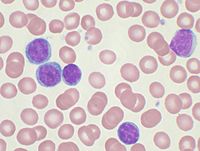
Photo from wikipedia
The ultraconserved regions (UCRs) are the genomic segments manifesting perfect conservation between the orthologous genomes of humans, rats, and mice that get transcribed into mono-exonic long non-coding RNAs (lncRNAs) known… Click to show full abstract
The ultraconserved regions (UCRs) are the genomic segments manifesting perfect conservation between the orthologous genomes of humans, rats, and mice that get transcribed into mono-exonic long non-coding RNAs (lncRNAs) known as transcribed ultraconserved regions (T-UCRs). Increasing evidence demonstrates the importance of T-UCRs in human cancers, however, their involvement in the pathogenesis of Chronic Lymphocytic Leukemia (CLL) is poorly understood. Our lab has recently identified a lncRNA transcribed from a UCR and named it TRUC-16 (Translational Regulatory UltraConserved gene affecting p16), which is overexpressed in CLL and correlates with treatment-free survival. We have developed a transgenic C57BL6 mouse model to overexpress TRUC-16 in B cells. We monitored the number and development of B cell subsets over time in peripheral blood and lymphoid organs (lymph nodes, spleen, and bone marrow), and performed immunophenotyping to assess clonality and proportion of the cells considered to be the origin for CLL (i.e. B1 cells and IgM memory B cells that are CD5+). We followed mice survival (n=10 for each gender) and performed necropsy with histopathologic and immunophenotypic analysis. If blood sampling suggests developing a CLL-like state, we will monitor for evolution to Richter Syndrome by flow cytometry analysis and biochemistry markers. We have validated the TRUC-16 overexpression specific to the B-cell compartment in the mice cohorts and have observed lymphoma in several organs. Interestingly, TRUC-16 overexpressing mice showed significantly higher splenic weights compared to controls. The mice were found to develop adulthood lymphoma that we are now analyzing molecularly and phenotypically. We are planning to further characterize the subtype of lymphoma by utilizing specific diagnostic markers through immunohistochemistry and flow cytometry. This is the first-ever transgenic mice modeling overexpression of UCR in the context of cancer. Validation of the functional correlation between the TRUC-16 phenotype and CLL patients’ clinical data will provide a valuable resource to pursue a multitude of preclinical studies to find targets that might help better understand the disease pathophysiology. Citation Format: Swati Mohapatra, Erik Knutsen, Mihai Iurascu Gagea, Linda Fabris, George Adrian Calin. Deciphering the in vivo roles of a novel long non-coding RNA in chronic lymphocytic leukemia and Richter syndrome. [abstract]. In: Proceedings of the American Association for Cancer Research Annual Meeting 2023; Part 1 (Regular and Invited Abstracts); 2023 Apr 14-19; Orlando, FL. Philadelphia (PA): AACR; Cancer Res 2023;83(7_Suppl):Abstract nr 3795.
Journal Title: Cancer Research
Year Published: 2023
Link to full text (if available)
Share on Social Media: Sign Up to like & get
recommendations!